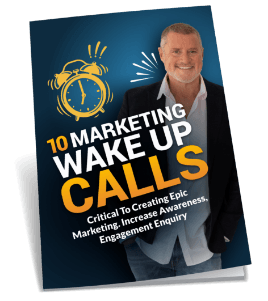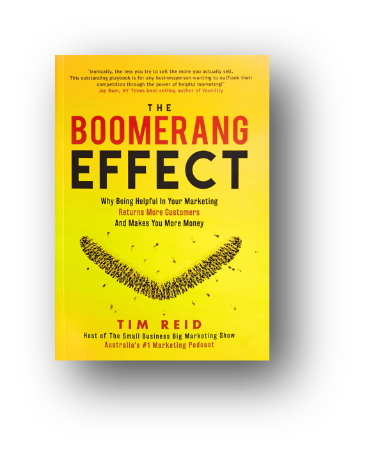In episode 382 Melbourne’s culinary king, Chris Lucas, takes us behind-the-scenes of how he’s successfully built and promoted some of Australia’s most exciting and interesting dining experiences. This is for anyone (not just restaurateurs) wanting to build a business that stands out from the crowd.
“I don’t get intellectually interested in what other people have done … my idea is about capturing what I think is right, and try to be creative and do something different. We’ve established a set of brands that do that, that are about being innovative and that create a level of excitement, and as a result, a lot of excitement. That’s what I think we should all be interested in.”
– Chris Lucas, The Lucas Group

There’s loads more tips and insights just like this that will help you build that beautiful business of yours into the empire it deserves to be. Hit the PLAY button or subscribe free to hear the full interview. You’ll also find the full interview transcription below.
If you have questions about how to grow and market your business successfully then you’ll get this answers in this interview:
- How do I find a gap in the market place?
- Why shouldn’t I just copy my competitors?
- How do I innovate in my business?
- Why & how should I challenge the conventions of my industry?
- How do I come up with a business model relevant to today’s customers?
- Where and how do I look for opportunities?
Chris’s successes in starting and promoting restaurants is amazing. As well as the super-successful Chin Chin, he has a stable of some of Melbourne’s most popular eateries: Baby Pizza and Japanese/Korean-inspired Kong BBQ in Richmond, as well as Hawker Hall, a food and beer hall in Windsor, where the hip and the hungry queue to get in. And he’s recently opened Kisume, an upmarket Japanese Korean dining experience.
Here’s what caught my attention from my chat with Chris Lucas:
- Go where the demand is and find a gap in the market … learn to see opportunities where others don’t. In doing so, avoid doing ‘me too’. As Chris said, “doing me-too doesn’t intellectually interest him!”
- Come up with a product and business model more relevant to today’s customer. Sometimes we do things just because that’s how everyone does them … maybe it’s time to break a few rules and do things differently? Innovate and constantly evolve your business model.
- Look for fun places to take your clients, suppliers and staff. This is not something Chris and I spoke about, but that chat reminded me of an idea I shared in a past episode, where I suggested us business owners should never eat alone; or, at least once a week we should get out of the office and have a business lunch with someone. I’m catching up with an overseas listener for dinner tonight!
Chris Lucas Interview Transcription
Tim Reid:
Now, my son did VCE last year and he did business management as one of his subjects. So, I got to start having business conversations with him and we would be driving around and he’d be pointing at restaurants and cafes and saying: Dad how do they make money.? And I sometimes just didn’t have an answer for it. What should I have said?
Welcome to Australia. Have a nice day.
Chris Lucas:
I got the penalty right. Well it’s you know it’s probably in many ways it’s not much like it. It’s not much different to any other sort of retail business. I mean we restructuring probably face some of the highest labour costs in the Western world. You know occupancy costs in Australia are very very high as well. So it’s a tough business. It’s a very competitive business as well which makes it even you know adds another dimension to it. So, there’s no doubt there’s a lot of operators out there who are probably struggling to make ends meet, but it’s a very dynamic industry at the same time and it’s also in terms of if you aggregate the numbers, it’s one of the largest employers in Australia.
If you take the services sector at large including hotels and tourism and so forth and it’s a fast growing industry so everyone wants to be in the restaurant business for some peculiar reason.
Tim Reid:
Yeah, they do. Lifestyle?
Chris Lucas:
Oh, look I think it’s getting into the restaurant business it’s a reasonably affordable still. Nowadays, young kids can get into the business just with a few hundred thousand dollars I guess opening a little café. They get to be their own boss in charge of their own destiny and you know chance they’re armoured at trying to do what they think they want to do.
Chris Lucas:
Plus, there’s a whole intellectual movement in terms of food around the world. All of a sudden, people are very interested in particularly young people which is a good thing probably interested in what they eat and what their lifestyle was all about and being healthy and conscious about where food comes from etc. and it’s become quite a sort of a fashionable thing to be an expert in coffee or some sort of particular protein where it’s coming from more sustainable products organic products etc.
Tim Reid:
And the celebrity chef movement I would imagine.
Chris Lucas:
Oh yeah, to a certain extent. I mean the celebrity things are a bit it’s there but it’s probably overhyped as it is, right.
Tim Reid:
Have you got a favourite celebrity chef? I mean I need to know.
Chris Lucas:
Gordon Ramsay.
Tim Reid:
You like Gordon Ramsay?
Chris Lucas:
Well, I know Gordon reasonably. Well and I’ve watched Gordon develop from a not so famous chef to obviously one of the most famous chefs in the world.
Tim Reid:
Is it own show?
Chris Lucas:
Pretty much yeah.
Tim Reid:
Really?
Chris Lucas:
Very interesting personality actually is quite a salesman Gordon. I swear a lot in real life.
Tim Reid:
Well, there you go. It’s not so much show. You have got some incredible restaurants. I said on a phone call to you the other day I haven’t been to any of them, but I absolutely lied as I said to you early and they offer a wonderful experience. Where do your ideas come from?
Chris Lucas:
Well, to me it’s just an instinctual thing. You have a sort of a gut feel about where you think the market is and it doesn’t happen overnight just like most success stories I guess they sort of they come from hard work in many many decades of understanding what you do and how you apply your art and to a certain extent I go on what I think where the demand is where the gaps in the market are and quite frankly even though the market is very congested If you look at it from the outside, consumers have an enormous choice in Australia, but not just in food retail or in fashion retail. In many respects, we’re a small population, but we’re over serviced in many many segments and food is no different, but I still see a lot of gaps in the market. I see opportunities perhaps where other people don’t see opportunity and I guess that’s what it comes down to.
Tim Reid:
Can we just dive a bit deeper into that. So, can we choose one of your restaurants you choose and take us through the process from one day going. I’m going to do that and then bring it to market.
Chris Lucas:
Well, I mean Chin Chin is probably the most famous one it’s arguably the busiest restaurant in the country depending on which way you look at it.
When I was thinking about what the what was happening to the market I just sold one of my businesses back in 2007 and then they just sort of GFC had hit and had a bit of up it obviously had a bit of an effect on the market. People perhaps weren’t going to top-end dining restaurants and they were looking for other experiences, but like my father used to say he was a chef and a publican back in the 40’s and 50’, is one thing you can count on. People still need to eat.
Tim Reid:
Correct.
Chris Lucas:
Usually three times a day. In your case definitely three times a day.
Tim Reid:
Wow. I thought he said that maybe I’m dreaming.
Chris Lucas:
And so it was just a question of trying to come up with a product and a business model that I think was more relevant to today’s diner and I saw a change in the market. Young people obviously were thinking more about food and wanting to go out more often they had more disposable income, but they didn’t want to spend as much money, but they wanted to go out more often. It was pretty simple equation. So, we basically created a model which was built around redefining the casual dining model. I also felt that people were starting to as I said I’m more interested in food so it’s been having a bit of a negative impact on the fast casual dining section. Your chains and so forth where people are wanting to improve what they’re eating and they’re also looking for a slightly better experience. So, there was a bit of a dynamic change already going on. The industry was sort of slow to grasp, but as you know as most industries are and so my view was that I wanted to sort of drop the pricing to the point where it was almost competitive. Let’s say with the fast dining sector, but still give them a restaurant experience so that they could afford to go out more often, more regularly, but still have a reasonably good experience. In the restaurant business, I define a restaurant very simply as table service. So, you don’t have to queue up. In McDonald’s you have to queue and put your ordering.
So, we have to drive through. S,o that’s the fast casual sector. So, I want to be able to give people table experience, but keep the spend down to around about 50 dollars a head let’s say for an average dining experience including beverage which we manage to do and all of a sudden it’s sort of all it all worked it all came together it was the right time. The look was right we still spend just as much money making the place look cool and groovy and we did a few things around the music that was a bit more engaging. We broke a few rules.
Tim Reid:
Like what?
Chris Lucas:
Well, we dropped the reservations model. So, the reservation was a big change in our industry. In my view it held back the industry because most times if you want to go out at night. What’s the most common time you want to go eat?
Tim Reid:
Chris Lucas:
7:30 to 8:00. So, I’ve got a whole restaurant sitting there with staff and chefs prepping away, but most people only want to eat between 7:30 and 8. So, we dropped the reservation system.
Tim Reid:
And just to be clear in the industry at the time everyone was taking reservation.
Chris Lucas:
Most people there were hardly. I mean other than as I said the fast casual sector was obviously you don’t do your reservations there, but most restaurants have a reservation system.
Tim Reid:
So, it’s interesting. He broke the rules. I mean we all want to break the rules in the business in order to move forward in order to differentiate ourselves.
For you, is that a big decision or you know big decision?
Chris Lucas:
It’s a big decision because the media were against me at the time. They were saying that we were causing people all sorts of harm you know people weren’t able to book babysitters and people wanted to get into the restaurant but they couldn’t get in because they couldn’t make a booking and they had to queue up. So, the media sort of ran a bit of a campaign because know media are the media as Donald Trump says fake news and one of the biggest fake news was that people weren’t prepared to wait. The funny thing was if you made the experience amazing and you change the value argument was what we did. We brought the experience down to 50 dollars a head on average for a restaurant experience and so people all of a sudden thought the value argument was amazing and so they were prepared to wait for it. And if you actually talked to a lot of the young kids, they thought was pretty cool too wait. They go and have a drink or they sit on their phone or they do all these sort of things. And that’s probably the other element that came into it was the technology Instagram, Twitter was just coming on board and that is also had a huge dynamic.
Tim Reid:
All right. Well hold that thought. I want to have a whole marketing discussion. I want to go into customer experience. Social media but you are big on don’t do me too and there’s a lot of businesses again. There’s a lot of businesses we see open that are me too businesses this like again. Why would they do that? You’re completely against it. That makes sense. Point of difference is everything.
Chris Lucas:
It might suit some people, but I don’t get intellectually interested in things that other people have done to a certain extent. I want to copying someone else’s business or someone else’s model. My idea is about trying to capture what I think is right and trying to be creative and do something different. We’ve established a set of brands that are about doing that about being innovative and they create a level of excitement. So, I’d rather be in that side of the square at this stage. I mean there’s a lot of people making money in the me too side of the business. but in what we do is there’s a lot of excitement and a lot of brand loyalty that’s created by being an innovator.
Tim Reid:
You talk a lot about redefining the market which again. Why is business owners. That’s a scary proposition it’s much easier to fit into a market.
Chris Lucas:
Yeah. Look it is true.
Tim Reid:
How do you redefine a market?
Chris Lucas:
Well, you’ve got to be brave to a certain extent. You don’t go to bed at night thinking about what the risks are. I try to mentally not even think about the risk to be honest. I mean I plan for the risks. I mean we’re not stupid. So, we take it. We do our normal sort of considerations as to what we think might work or might not work, but I very rarely think about failure. It might be a good thing be a bad thing. I don’t know.
Tim Reid:
Can I just understand that process inside your head. Do you actually fear comes to you and you just push it aside or have you trained yourself you never ever feel.
Chris Lucas:
I’ve never really feared much. That’s normal isn’t it.
Tim Reid:
Very normal. Big spider on the shoulder, but don’t worry about that.
Chris Lucas:
I feared my children hate me as well.
Tim Reid:
As you add more restaurants to your portfolio. How do you maintain that? Because it’s quite a trendy industry. How do you maintain momentum and interest and not become just a fad.
Chris Lucas:
Well, food retail is no different to fashion retail.
Tim Reid:
They’re just pretty fickle.
Chris Lucas:
Well, they can be fickle, but look if you’ve got a good product and you continue to do what I believe in which is innovate continue to constantly evolve your business model. Not less on your roles and continue to create product that’s exciting. It takes the fickleness out of it to a certain extent and as I said it does happen to be positive in the fact that we’re in an industry as I said it’s an energetic industry. People want to know about it. I’ve been to a lot of few political dinners and a few business dinners where we sit around and is the head of some big corporation here in the head of the bank over here and people go around say what do you do. What are you blokes as on the Managing Director of xyz and I’m the chairman of this and there you. What do you do. I said I run restaurants. Oh really. All I wanna do is talk about restaurants. It’s a sort of a personal experience. I think people it’s an opinion-based business.
You go to a restaurant you have a very personal experience when you walk into a restaurant you don’t like this or you do like that or you want your food in this particular way. So, you’ve got to sort of dig into that and make sure that you know you’re on top of it. So you’re only as good as your last meal as they say in our business.
Tim Reid:
Let’s talk marketing because you mentioned the word brand before and again you’re one of these restaurateurs that you are you build these individual brands that have so much depth and emotional. Many people attach emotionally to them. There’s a lot of restaurants out there like the local Thai restaurant near where I live I mean it’s not a brand. It’s a very functional restaurant. What is the key to building a brand?
Chris Lucas:
Well, I took a particular view a few years ago that the apposed to say America which is you know 350 million people probably 100 million live on the basic wage and maybe another 30 or 40 million live below the poverty line so to speak which is a bit of an indictment about America, but you’ve got an enormous powerful base there that basically feeds off low based commodity based restaurants fast food chains which is why a hamburger chain if it’s successful can open up a thousand fifteen hundred two thousand. Some businesses can get through that growth in a very quick period of time because they’re able to scale up. In Australia, the fast food sector which is what most people see brands and understand brands as in terms of the food business he’s got a lot of structural barriers to it. So, it has a limitation in the sense that it has a ceiling in the sense that you are only prepared to pay so much for let’s say a burger. I mean you probably won’t pay 30 or 40 dollars for a burger.
Tim Reid:
I would but you know.
Chris Lucas:
You know there’s a ceiling usually around about 10 dollars. So, you can’t really add to that experience in Australia. So, you’ve got it. That’s why these fast casual brands have to have multiple sites. In Australia it’s tough. You’ve got as I said the highest labour costs in the Western world. You’ve got a scarcity of cheap labour and you’ve got some of the highest property prices in the Western world again. So, you got huge occupancy cost. It cost more to feed out our businesses in Australia than it does in America and so these structural inefficiencies and these barriers I think mean that we can’t scale up in Australia as quickly or as significantly as you can in America. So, the fast casual sector in Australia to me brand development point of view has got some limitations. There’s already some well established brands and they dominate the market but they’re struggling with growth as well. If you look at your McDonalds and so forth and even chains like grilled which have tried to do something different are hitting a sort of a ceiling.
So, my view was to try and create a brand identity, but to do it with multiple different brands.
If that makes sense.
Tim Reid:
Yeah, it does.
Chris Lucas:
So, it was about trying to step away from that part of the commodity business and move it more into a business where we could change the value argument still make it as I said a restaurant experience drive the cost down through making the restaurants as busy as we possibly can. So, we took away the reservation systems and then we sort of really worked on making the brand’s exciting. I mean what’s so exciting about going to a Kentucky Fried Chicken outlet. but there a lot of excitement in going to a Hawker Haul.
Tim Reid:
So, let’s go there because Hawker Hall is a great experience of customer experience and in a world of sameness customer experience these days seem to be a way of differentiating a business run. So, how do you go about do you timeline out from the moment someone comes into contact with Hawker Hall these are the hoops they’re going to go through to enjoy themselves.
How do you create an idea?
Chris Lucas:
Well, there’s a guy called Stephen Starr In America that runs a really quite successful business group again multiple concepts. You might have heard of resonant friends like Buddakan in New York which is a very famous restaurant New York. When you go into it sort of like a nightclub comes sort of Chinese restaurant.
He was a film producer from from Philadelphia. Stage shows, movies. He took his entertainment model and I think put it into a food model and created dynamic fun restaurants to go to. So, he changed the whole dynamic of the restaurant industry. It went from being a place to just go and eat something and basically turned it into an all night affair. He also made his restaurant’s large scale format so he became the bunnings of the restaurant industry. That’s a sort of an analogy in the sense that it’s a one-stop-shop. You can go in and go to a bar, you can go to a restaurant, you can go to noodle shop you can eat dumplings all in this 25-30 million dollar facility which had thumping music through the whole place and all of a sudden these large scale format large footprint businesses started generating huge amounts of cash. It became I think one of the busiest restaurants in New York one of the business busiest in America. They did another model of it in Vegas where one single resident was turning over 70 million US. The one in New York was doing about 35 million US which was unheard of before and the whole restaurant industry. And it also made the experience as I said a sort of an entertainment. So, people then started to realize that restaurants could be something more than just a traditional eating house and that allowed us and let us as well to sort of look at that model use it as an inspiration which is what we’ve done with our businesses and it allows you to also add on them. So, there is no limitation anymore it’s not the 10 dollar burger we can sell you a cocktail, we can sell your cookbook, we can sell you all sorts of things. So, it’s about creating the right environment. Making people feel that the value of experience is something different to everywhere else and all of a sudden in some ways they’re actually spending just as much as they used to in a traditional restaurant.
They might end up spending 200 box ahead because they’ve had a few cocktails buy a cookbook, buy this or buy that, they’re up to this, but they feel as if the experience has been an affordable one.
Tim Reid:
Do you actually map it out? I interviewed an electrician about a year ago and he had a large electrician’s franchise in Australia. The owner had mapped out a 21 step customer experience mantra. Every time a sparkie went to a home or business in order these are the 21 steps that they had to follow and as a result there was a consistent experience. It was a good experience and people talked about it and as all the business owners in this room whether there’s a vet or a lawyer or an accountant they can still offer an experience.
Do you go to that level of detail?
Chris Lucas:
Not quite to that level of detail. I started my career I did pharmacology at university which was probably a mistake. I know that the head of the faculty told me to never ever ever go into that business because I’d probably kill someone. So, he said what are you good at. I said I what do you think I’m good at. You’re not gonna good at mixing up drugs. He said well and he said you should just go in to be a salesman.
Tim Reid:
Sell drugs.
Chris Lucas:
So, I said I don’t want to sell drugs that’s a bit boring he said. There’s a company called IBM and I said who is that. He said it’s the world’s biggest computer companies back in 1979.
So, I joined IBM at the time as a trainee salesman and IBM is magical because IBM was arguably at the time as well before Apple was probably the leading company in the world in terms of marketing. I mean that was a great marketing machine and the first thing I learned was that the customer is the number one person. They said the same thing. If a salesman doesn’t sell anything, no one else gets a job and the customer is always right and the customer is always first within reason. So, they used to have all these sort of mock sales experiences they used to set up in the training facilities. The other thing I learned from them is that it’s all about training. It’s about investing in your people making sure they understand the culture and understand the experience that you’re trying to give your customer. So, I’ve basically learnt that I’ve got that drilled into me when I when I first went into the workforce and I apply that to our business. It doesn’t matter. I mean you’d probably beat a lot of cool and 20 restaurants and you get some young kids with things stuck through their nose and long hair and a few tats on them and looking down their noses saying to you I’m not sure I can do this for you. We’re really busy I’m not so sure I can find you a table that doesn’t happen in our places.
So as soon as you walk in the door, it’s a big smile on their face. We call them the gatekeepers. So, we put a lot of training because it doesn’t matter how good your business is. One kid with the wrong attitude can undo all your assets, all your good work. Because they’re the link between you and the customer who comes in the door.
Tim Reid:
So, most business owners find people the most difficult part of running a business. How do you attract and retain the good ones?
Chris Lucas:
You’ve got to create a model that’s exciting. For us, most of our employees are under the age of 30. So, it’s about dealing with that youthfulness. So, we create an environment which is cool to work in it’s a bit the Google of the restaurant to a certain extent. They can sort of their free will in my place a bit so they don’t feel as if they have the total sort of normal structural elements that they would have in a normal workplace, but at the same time we said very very sort of high benchmarks in terms of the customer first experience. We spent a lot of money on training probably more than anyone else in the industry for the type of business we are.
Tim Reid:
The obvious training or is there some not so obvious training?
Chris Lucas:
We do a lot of cultural training. I mean look at the end of the day you can train someone as much as you like. They still might screw up because the brain can only take so much and they tend to forget it when they’re in a pressure situation. So, we work a lot on culture I think and then we let them go because I think if they’ve got the right cultural attitude i.e. for us the customer is right in my in my business then, they can make their decisions on the run knowing full well in the back of their mind. Well, Chris Lucas wants his customers to be happy and then they can make their own decisions based on the cultural aspect.
So, for us ,it’s all about culture. We don’t always get it right. It’s a tough business. Our kids are there today they sort of tend to know a little bit more than what they thought. They know they do. But look on the flipside is that they’re very intellectual. They’re well trained. Most of the day well read. They can flick through their iPhone and pick up just about anything. Anything you want and they grasp it very quickly.
They’re a lot taller which is always good too. So, it’s about making sure that we just gelling with that generation, but making sure that there are still some old fashioned values that matter.
Tim Reid:
And does that apply in the background to all your restaurants.
Chris Lucas:
Yes.
Tim Reid:
So, there’s a sort of a continuity.
Chris Lucas”
Applies to everyone in our business. IT, HR, ect.
So, we put a lot of people from headquarters into the restaurants. We cross our fingers a bit. When we got in there in the restaurant but it’s a good experience for them. They got to see what it’s like to deal with customers and deal with customer demands.
Tim Reid:
Speaking of IT, What role technology we here on behalf of urban intelligence. What role technology?
Chris Lucas:
Well, for us that there’s a couple of elements. We’ve got our own disruptor which is the food delivery business at the moment. Melbourne has become the #2 uber eats delivery business in the world. So, I just think London is #1. Melbourne is #2. It’s only been in business for 12 months. So, the pent up demand was huge because we didn’t have a delivery network in this country really. Domino’s had really broke the model thereby rationalizing their stores and going to a delivery and online business which they have done very successfully, but the rest of the industry had to grapple with hiring bicycle riders and insurance and paint people 50 box an hour on Sunday to do that. So, we never really had a what I call an established delivery service, but the demand was there. All of a sudden these guys come in. They provide a really swish IT platform which is the apps and they’ve also obviously got a driver network established; so all of a sudden a business has been created out of nothing and in fact, Uber Eats I think is growing at a faster rate than their normal business, in a lot of the developed countries at the moment.
Tim Reid:
Have you seen an impact?
Chris Lucas:
Yeah. We’re on it. We have to restructure our restaurants to be able to cope with this whole genres.
Tim Reid:
Was it that difficult?
Chris Lucas:
It is because you know restaurants are designed to feed people in their restaurant. Our food is designed to be served in a restaurant. So, it comes you hot usually at your table to try and restructure your menu and restructure your kitchens and your resources to be able to then transport food even though there’s a 5km radius it’s still significant. So, we have to do a lot of work in doing that, but we recognized it was a business opportunity wasn’t going to go away. It was something that we had to deal with and we’ve taken it on as a positive, but we were we were worried about our brand. I mean we didn’t want our food arriving cold. It’s a negative for our brand. So, we had to make sure that the experience was as best as we possibly can be.
So, that’s one that’s one area that we’ve had to deal with and I think it’s here to stay where it goes in the next couple of years will be interesting because Uber is I think learning the business themselves and they’re not quite sure where it’s going. They just want to they just have a very simple philosophy which is they don’t care whether they make money or not at the moment and they’re losing a lot of money doing this business.
Tim Reid:
But as a philosophy generally for business owners in the room, we don’t all know what we’re doing right?
Chris Lucas:
They really don’t know what they’re doing.
Tim Reid:
So it’s a bit scary given the sort of recoveries. How does that work?
Chris Lucas:
It’s actually an interesting exercise. The CEO of Uber he pushes his limit there’s no doubt about it. He even push his limits with Apple to the point that Apple is going to drop his app. So, which would have been a major problem. So, his view is that he wants to dominate the marketplace depending on what sector they go to and he makes no qualms about it and he’s burning a lot of cash to do it. I guess to a certain extent Amazon didn’t make a lot of money for almost 10 years even now. There’s a lot of parts of their business that don’t really make a lot of money or a very small margin. The big money is actually in their cloud business. So, people don’t really know that, but Amazon was actually really an IT company. Just happens to be a retailer. So, a lot of their money is coming out of their cloud services business which is growing at a phenomenal rate. So, that’s one disrupter. The other one is social media. For us, social media has been a huge change in the way restaurants operate. I mean you probably see it today you go into a restaurant there’s kids sitting around a table and no one’s talking to each other they’re just taking photos of the food or taking photos of each other or taking photos with their girlfriend or doing whatever and posting it. So, that’s been a phenomenal change a great change for us. It was interesting. We had a lot of people in the industry going, oh I don’t want people taking photos of my food I don’t think it’s right. It’s disrupting the customer experience. Our view was open the doors come in take as many photos if you like I’ll pose with you as well.So, because at the end of the day it was free marketing.
Tim Reid:
Totally.
Chris Lucas:
Free marketing and it was like standing in front of a tsunami. There was no chance you’re going to stop people from taking photos in your restaurant. So, get on board which we did. We were probably do the leaders. I guess my IT background probably helped a bit to get onto it quicker than most. I remember sort of must have been 2010 or 2009 that whole apple phenomena retail apple phenomenal was just happening. I was in New York and I was in a really cool hip hotel the Mercer in Soho and I was sitting down at the bar restaurant area and looking at all the beautiful models and every one of them had a laptop or iPad or a phone.
In fact, I saw one family there was two kids and parents all four had laptops. The smartphone thing was just coming on Instagram hadn’t started and I was looking and was thinking to myself that it’s a bit said no it’s talking to each other the pervasiveness of social media is here. It’s here to stay and it’s a big part of what we do. So, we build a business around communicating our brands through social media.
Australia’s culinary king, @ChrisLucasFood, on how to successfully promote a restaurant #hospitality #marketing https://t.co/bY0qdhbuxR
— Timbo ?? (@TimboReid) September 19, 2017
But the marketing gold doesn’t stop there, also in this episode:
- You’ll discover where to look for ideas to get more customers – and it’s not where you think
- The importance of owning your brand’s personality is made crystal clear
- And we revisit an episode in which my Joep Pennartz built an entire business called Shacky around #JOMO – the joy of missing out!
Other resources mentioned:
Today’s listen question came from Erin Miller Massage
Thank-you to photographer Simon Schluter for the amazing photo of Chris Lucas
Please support these businesses who make this show possible:
Open Universities Australia – Check out Open Universities’ online courses for business owners over at Open.edu.au. Someone’s gotta be the smartest in your industry – it may as well be you!
Dale Beaumont’s 52 Ways – An amazing free 1-day live event for business owners where you’ll discover 52 ways to boost your business profits. 2018 dates announced. Seats are limited. Book now.
If some thing in this episode of Australia’s favourite marketing podcast peaked your interest, then let me know by leaving a comment below.
May your marketing be the best marketing.
Timbo Reid
Want to subscribe to The Small Business Big Marketing Show?
Subscribe FREE on iTunes or Android




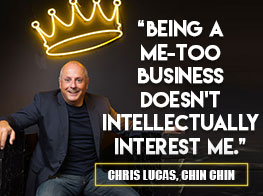



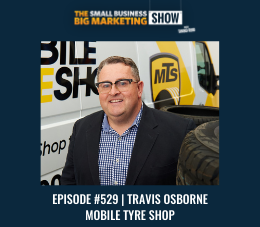
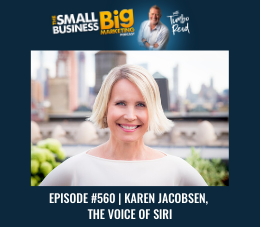

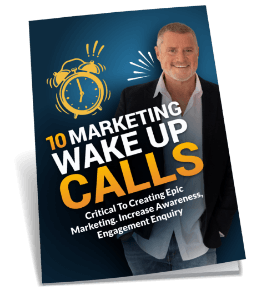
 Grab My 10 Marketing
Grab My 10 Marketing